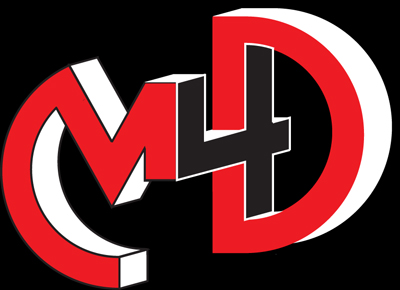4-Wheel Drive
 | Audi Quattro pioneered 4WD technology in 1980 .... not only dominated rally series, its designer also claimed, "One day, 4WD will become as popular as 4-wheel disc brake in today.".... |
 | Today, Audi builds 4WD versions for every of models. This S4 is the high-performance version of A4 sedan .... |
 | But 4WD still links strongly to rally. Rally brings us some superb machines like this Subaru Impreza WRX Ver IV STi. |
Advantages and Disadvantages
We all know the objective of differential. During cornering, the outside wheels have to travel faster than the inside wheels, therefore we need a differential to distribute different torque to the wheels. For a 4WD car, we in addition need the Centre Differential because the front wheels have to travel faster than the rear wheels. The following diagram illustrates this :
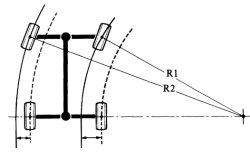
LSD - the core of 4WD technology
 This is the LSD used by Subaru Impreza WRX Ver IV STi
This is the LSD used by Subaru Impreza WRX Ver IV STi
However, just the 3-differential layout alone cannot cope with the basic requirement for 4WD - provides superior grip in the worst roads. In real world driving, for instance, when pushing the car over its limit in corner, or running on slippery surface, tyre slip is inevitable. When a wheel loses traction, a normal differential will transfer nearly all the driving torque to that wheel. As a result, the spinning wheel will spin even wilder, but the wheel that having traction will never share driving torque, therefore the car will be difficult to get out of the trouble. This problem occurs in all kinds of car, no matter 2-wheel drive or 4WD, but it is relatively more important to 4WD because 4WD cars are designed to run in worse roads or cornering harder.
Therefore 4WD cars (or even many latest 2WD sports cars) need Limited Slip Differential (LSD). A LSD lock up both drive shafts whenever tyre slip occurs, thus helps the car get out of trouble quickly. The result is enhanced stability and even higher cornering limit.
In fact, LSD is the core of 4WD technology. There are several types of LSD: Torsen LSD, Viscious Coupling LSD, VC differential lock and Active LSD. They have different effectiveness, characteristic and cost so that car makers choose them according to their needs. Now we are ready to look deeper inside these 4 types of LSD.
Different types of 4WD
1) Torsen differential - Audi Quattro system*
- Being the master of 4-wheel drive, Audi always insists to use the most effective system despite regardless of price. Its Quattro 4WD system* uses a pure mechanical LSD, Torsen differential.
Torsen, means "torque-sensing", was invented by an American company calls Gleason Corporation. Its slip-limiting ability is implemented by cleverly using worm gears / worm wheel pair. This pair has a special characteristic: driving torque can be transfered from worm wheel to worm gear, but not reverse. Otherwise, they will be locked up. It is such characteristic that limit slip.
 | A: Differential housing B: Out axle C: Worm wheel D: Worm gears E: Synchromeshes F: Hypoid wheel (from engine) G: Out axle |

- The above picture explains how Torsen differential works. In normal cornering, i.e., no tyre slip in any wheel, Torsen differential provides the same function as a normal differential. The addition of worm wheel / worm gear pair does not affect speed difference between output shafts. For instance, if the car turns left, the driveshaft to right wheel runs faster than the differential housing, while the driveshaft to left wheel runs slower than the differential housing. The speed difference between left and right worm wheels can be exactly matched in the synchromesh gears. Note that the worm gears / worm wheels pair do not lock up because torque is transfered from worm wheels to worm gears.
When one of the wheels, say the right wheel, loses traction due to poor road surface or whatever reason, the worm gear / worm wheel pair get into effect. At the instant just before they become effective, one must know that by the basic differential theory no torque will be sent to the left wheel, which is with traction. Instead, all the torque will be sent to the spinning right wheel. Then, the fast-rotating right worm wheel will drive its worm gear, through the synchromesh and drive the left worm gear. Now, do you still remember the basic characteristic of worm gear / wheel pair ? Well, when worm gear drives worm wheel, they will be locked up. As a result, the left worm gear and right worm gear are actually locked together, thus wheels on both side will rotate at the same speed and get the car out of the lose of traction.
Characteristic of Torsen-equipped 4WD
Except the first generation Quattro system that appeared in the early Quattro coupe, most of the subsequent Quattro systems used Torsen differential in center and rear axles. This is rather expensive. However, Torsen-equipped 4WD has many advantages. First of all, its pure mechanical parts react almost instantly to tyre slip. Secondly, it provides linear lock-up characteristic. Thirdly, it is a strictly permanent 4WD system. In normal condition, torque split between front and rear wheels is 50:50 (other ratios are possible, depends on the pitch of worm gears).Apart from Audi, few other car makers adopted Torsen LSD, mainly because of cost reason. Toyota's rally ace, Celica GT4 was one of the few exception. It used Torsen in the rear axle. This might be part of the reason why it was so expensive over competitors.
| Advantage: | Quick response, permanent 4WD |
| Disadvantage: | Pricey, torque split not variable |
| Who use it ? | All non-Golf-based Audi quattro models, Toyota Celica GT4, Hummer etc. |
Note: * the "Quattro" mentioned here is the traditional Torsen system marketing in the name Quattro. That includes all Quattro models until the arrival of Audi TT (which uses the Haldex system). Since then the name Quattro becomes a marketing trade mark rather than indicating the actual mechanism. At the time of writing, all Audi Quattro models, excluding the Golf-based A3, S3 and TT, still employs the traditional Torsen system.
- Viscous Coupling center LSD is commonly used in many simple 4WD systems. One of the earliest examples was Volkswagen's Syncro system.
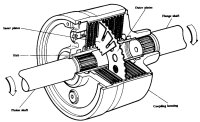
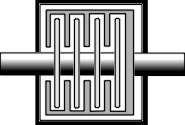
Inside a viscous coupler as shown in the right hand side picture, there are many circular plates positioning very close to each other. Both drive shafts connect to roughly half of the plates in an alternating sequence as shown. The sealed differential housing is fully contain of a high viscosity liquid, which has a strong tendency to "visco" those plates together.
In normal condition, front and rear axles run at roughly the same speed so the plates and viscous liquid are relatively stable to each other. When tyre slip occurs in one of the axle, that means the alternating plates run at different speed, viscous liquid will try to visco them together. As a result, torque is transferred from the faster driveshaft through the liquid to the slower driveshaft. The greater the speed difference, the larger the torque transfer. As a result, limited slip function is implemented.
Characteristic of Viscous Coupling center differential
Note that Viscous-Coupling LSD is a speed-sensing device: under no-slip condition, no torque will be sent to another axle. Whenever slip occurs, theoretically up to 100% torque can be sent to any axle, depending on the traction difference between front and rear axle. Therefore it is a part-time 4WD.Being a part-time 4WD, it does not have the neutral steering of a permanent 4WD can obtain. For cars based on rear-wheel drive models, such as Porsche 911 Carrera 4, this is not a real problem - as normally the car runs like a RWD car thus is capable to deliver the desirable throttle oversteer . However, for other front-wheel drive-based cars like VW Golf Syncro and Volvo 850 AWD, the part-time 4WD can do nothing to correct their understeering manner. This is the first disadvantage.
The next problem is the delay before the 4WD get into effective. Since viscous liquid is not a fixed medium (unlike gear), it takes time and speed difference to be effective. The function between speed difference and torque transfer is an exponential function - that means in the early stage of slip, torque transfer remains near zero.
To cure this problem, most manufacturer varies the final drive ratio such that introduce a slightly speed difference even in normal condition. As a result, the car actually runs with 95:5 torque split between front and rear. This shorten the delay time. However, it is still impossible to match the pure mechanical Torsen LSD.
It might be less effective than Torsen system, but it is certainly the cheapest, so we can find it in many mass production 4WD cars.
| Advantage: | Cheap and compact |
| Disadvantage: | Part-time 4WD only. Normally feels like 2WD. |
| Who use it ? | VW Syncro, Lamborghini Diablo VT, Porsche 993/996 Carrera 4 and Turbo, Volvo 850 AWD etc. |
- Lancia Delta Integrale (with Torsen in rear axle)
- Ford Escort RS Cosworth (with Viscous-Coupling LSD in rear axle)
- Mitsubishi Lancer GSR, 3000 GT VR4. (with Viscous-Coupling LSD in rear axle)
- Subaru Impreza and Legacy manual versions (with Viscous-Coupling LSD in rear axle)
- Toyota Celica GT4 (with Torsen in rear axle)
- Bugatti EB110 (set to 70% rear bias)
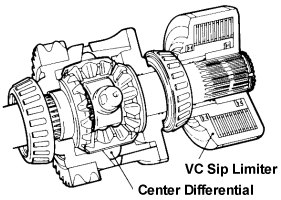 While Torsen 4WD is too expensive, Viscous-Coupling LSD is part-time only, most 4WD cars, including the rally ace Celica GT4, Subaru Impreza, Mitsubishi Lancer and Ford Escort RS Cosworth adopted another kind of center differential - basically it has a regular center differential which distribute torque to front and rear under normal condition, an additional Viscous Coupling Differential Lock provides anti-slip function when needed.
While Torsen 4WD is too expensive, Viscous-Coupling LSD is part-time only, most 4WD cars, including the rally ace Celica GT4, Subaru Impreza, Mitsubishi Lancer and Ford Escort RS Cosworth adopted another kind of center differential - basically it has a regular center differential which distribute torque to front and rear under normal condition, an additional Viscous Coupling Differential Lock provides anti-slip function when needed.Characteristic of this system
The Viscous-Coupling Differential Lock is virtually the same as what we have learned earlier, therefore it also has slight delay and non-linear characteristic. However, in reality this might not be as serious as we thought, otherwise it would have been impossible that all the top rally cars use it. Moreover, Viscous-Coupling Differential Lock system is lighter and cheaper than Torsen system, while having superior effectiveness over the part-time Viscous-Coupling LSD system.| Advantage: | Good balance between price and effectiveness |
| Disadvantage: | No special flaw |
| Who use it ? |
- Variable torque split even in normal condition. Best use of traction.
- Since computer monitors and controls everything, theoretically it can cope with any normal or abnormal condition without being limited by the design of mechanical parts. The result is fast response and adaptive.
5) Part-time slipping transfer case - Ferrari 4RM
- Ferrari has long been refusing to adopt 4-wheel drive. To Maranello, conventional 4WD systems are just too heavy and bulky for its cars. They would benefit roadholding in rare occasions like running on snowy or wet roads, while most other time the extra weight and size would only worsen performance. Without deviating from its philosophy, Ferrari developed a very special kind of 4WD system called "4RM" in 2011. The technology was first fitted to its new 4-seater GT, FF.
The 4RM is a niche design for Ferrari's GT cars. It is built upon Ferrari's traditional FR architecture with a front-mid-mounted engine and a rear-mounted transaxle. The engine must be positioned completely behind the front axle line, something very few cars other than Ferrari can achieve.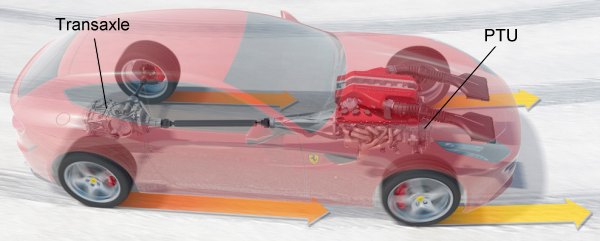
4RM system on Ferrari FFThe rear wheels get power just like a conventional FR car. What makes it special is the front-drive hardware. A PTU (Power Transfer Unit) is added just in front of the engine, taking power directly from crankshaft to supply the front wheels. This mean the crankshaft has output at both ends, one goes to the rear transaxle and another goes to the front PTU. The PTU contains a gear set and two wet multi-plate clutches. Each clutch is responsible for engaging a front wheel. By applying hydraulic pressure on those clutches, PTU can alter the amount of torque transferred to individual front wheels. This mean it achieves not only 4-wheel drive but also torque vectoring !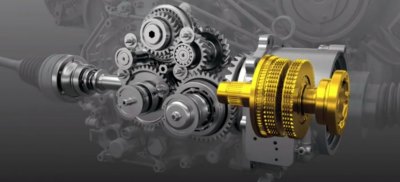
PTU
But what's the purpose of the gear set in PTU? It offers two gear ratios (plus a reverse), so you can see it as a 2-speed gearbox. Now you may question how the speed of front wheels can match those at the rear, which is driven by a 7-speed gearbox. The answer is: they don't match. The gear ratios in PTU are chosen such that the front wheels always spin faster than the rear if the car is lifted up in the air. On the road, this mismatch will force the clutches in PTU to slip all the time. This situation is similar to the PSK system used in Porsche 959 - that car employed front tires slightly larger than the rears, so the multi-plate clutch in its transfer case was always slipping. The case in Ferrari 4RM is far more severe due to the different gearing front and rear. This put its durability into big question.
Never mind. The 4RM is not supposed to be a permanent 4WD system. Ferrari wants to preserve the rear-drive characteristic of its cars as far as possible, thus it needs drive to the front wheels only at extreme moments, e.g. when the car is slipping in hard cornering, or running on slippery surfaces. Therefore it does not need to engage the front wheels all the time. Thanks to modern computer power, the 4RM's control module can engage/disengage the front wheels in a fraction of a second, and for multiple times in a second. Those short moments are already sufficient to put the car back on course. Moreover, the PTU takes at most only 20 percent of the engine torque, so there is no worry of overheating and overstressing it. Of course, one precondition is the gearing difference shall not be too big. That's why Ferrari gives the PTU two forward gears, with the lower gear serving the main gearbox's 1st and 2nd, and the higher gear serving 3rd and 4th. Above 4th, Ferrari considers the car should not be struggling for traction, so the PTU is disengaged, leaving the car to run by rear wheels.
The simplicity of 4RM means it has the advantages of lightweight and compact size. The PTU and its associated hardware on Ferrari FF weighs only 45kg, about half the weight of a conventional 4WD system. Compare with other 4WD systems working with front engine and rear-mounted gearbox, such as Nissan GT-R's, its weight and space efficiency are even more obvious. Moreover, it keeps the low center of gravity of FR cars, because the PTU takes power directly from the engine, saving the need to put an additional drive shaft underneath the engine.Advantage: Light, compact, low center of gravity. Disadvantage: Part time only, limited torque to front wheels, packaging requirement: engine must sit completely behind the front axle. Who use it ? Ferrari FF
4) Active differential
- Active differential 4WD is the most sophisticated one available today. Basically, active LSD is actually a multi-plate clutch enabling variable torque split between front and rear axle. The torque spit is controlled by computer which gather information about tyre slip and others from many sensors. Depends on design and software, some systems allow more precise control of traction during hard cornering, some achieve desirable understeer / oversteer, some can even make the best use of traction for acceleration and braking during normal conditions. Since active differential was pioneered by Porsche 959, we take the Porsche system as an example.
Porsche 959's PSK system - the most sophisticated
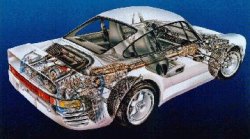 Until today, Porsche 959's PSK (Porsche-Steuer Kupplung) system is still the only one which make use of variable torque split for maximum traction under normal conditions. In most of the time, torque split between front and rear is 40:60, that is, the same as the car's weight distribution. In hard acceleration, weight transfer to the rear axle increases traction in the rear tyres while reduces traction in the front. Then PSK will transfer up to 80% torque to the rear axle in order to make better use of traction. On slippery road (even tyre slip is yet to occur), 50:50 torque slit is used. In any time, computer determines the torque split ratio by analysing parameters such as throttle position, steering angle, g-force and even turbo boost. Therefore PSK system provides optimum traction under all conditions, unlike other 4WD systems which can only varies torque split whenever tyre slip occurs.
Until today, Porsche 959's PSK (Porsche-Steuer Kupplung) system is still the only one which make use of variable torque split for maximum traction under normal conditions. In most of the time, torque split between front and rear is 40:60, that is, the same as the car's weight distribution. In hard acceleration, weight transfer to the rear axle increases traction in the rear tyres while reduces traction in the front. Then PSK will transfer up to 80% torque to the rear axle in order to make better use of traction. On slippery road (even tyre slip is yet to occur), 50:50 torque slit is used. In any time, computer determines the torque split ratio by analysing parameters such as throttle position, steering angle, g-force and even turbo boost. Therefore PSK system provides optimum traction under all conditions, unlike other 4WD systems which can only varies torque split whenever tyre slip occurs.Mechanism
Porsche PSK uses a multi-plate clutch instead of center differential. You may call it a "differential clutch" as well. The multi-plate clutch has 6 pairs of frictional plate, each pair is independently controlled by computer and actuated by hydraulic pressure. This simply equals to 6 independent clutches.
To make this system work, the front and rear driveshafts must run at different speed in normal condition. (so 959 adopted a pair of front tyres with 1% larger diameter than the rear's) Because of the speed difference between front and rear driveshafts, the 2 frictional plates of each independent clutch are rotating relatively to each other. When apply hydraulic pressure to the first clutch, a small amount of torque will transfer to the front axle. But note that the two driveshafts cannot be fully locked up unless all 6 clutches are locked simultaneously.
Now, you may see how it works: lock up 2 clutches, 3 clutches ... and the torque to front wheels will be increased, subsequently, torque split could be 50:50 if all the clutches are fully engaged. Of course, all these action is controlled by computer.
This is only for "normal" condition. Like other 4WD systems, when tyre slip occurs, most of the torque could be
sent to either axle.
What about energy loss and wear due to the slipping clutches? As the speed difference is very small, Porsche claimed energy loss is no greater than 0.4% of the power developed by the engine. As for wear, the clutch is dimensioned that it was negligible and caused no problem during the whole life span.
| Advantage: | |
| Disadvantage: | Heavy and expensive |
| Who use it ? | Porsche 959 only |
Mercedes 4-Matic - use under emergency
Mercedes 4-Matic is very much like Porsche's PSK, but it works as a part-time 4WD. In normal condition, the clutches are disengaged so that the car runs just like any rear-wheel drive version. When it lose traction, the computer will signal the clutches to engage progressively so to transfer some torque to the front wheels.This is rather irrational. It costs even more than Torsen system, but only offers part-time 4WD. However, unlike Porsche's PSK, it is not subjected to any energy loss or wear during normaly conditions, so the clutch can be made smaller and cheaper.
| Advantage: | No much |
| Disadvantage: | Part-time 4WD only; not cheap. |
| Who use it ? | Mercedes E-class 4-Matic |
Nissan Skyline GT-R's ATTESA E-TS PRO
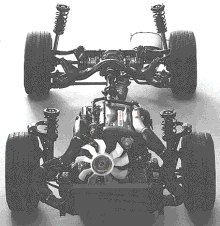 Since R33, Skyline GT-R also uses multi-plate clutch instead of conventional center differential, in addition, as rear differential lock too. Normally it is rear-wheel drive, the front wheels only intervene whenever necessary.
Since R33, Skyline GT-R also uses multi-plate clutch instead of conventional center differential, in addition, as rear differential lock too. Normally it is rear-wheel drive, the front wheels only intervene whenever necessary.What makes the Skyline system catches my heart is its real world behaviour. Without driving it or reading road test reports, you might not discover its maturity.
As I have mentioned earlier, throttle-controllable oversteering is usually more desirable to real drivers than pure neutral steering. However, what a pity most permanent four-wheel drive cars are inherently unable to deliver power oversteering. Porsche 959 was one of the exception because it had 60% weight bias towards the rear, but for a front-engined car like the Skyline GT-R, the best solution is to leave it as rear-wheel drive in normal conditions.
The clever electronic control system is fed by all the information that Porsche 959 had, such as G-force, boost pressure, throttle position etc, in addition, the speed of individual wheels measured by ABS wheel speed sensors. By these information, the computer knows whether the car is running out of cornering limit or not. If not yet, the multi-plate clutches won't intervene, thus the car can power slide through the corner smoothly. In case out of limit, the multi-plate clutch will engage and send torque to front wheels, increasing traction.
This makes Skyline a rare example of 4WD having oversteering ability.
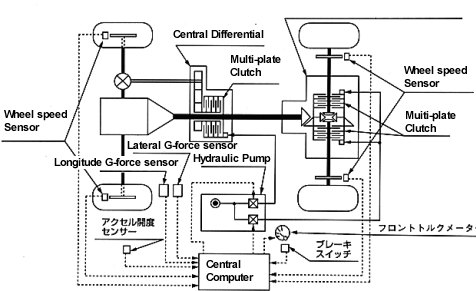
| Advantage: | Combines RWD's power oversteering with 4WD's maximum cornering limit |
| Disadvantage: | Like other active differential, a bit heavy and expensive |
| Who use it ? | Nissan Skyline GT-R |

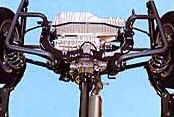
Since the late 1998, Volkswagen replaced the viscous-coupling Syncro system with a new system called "4motion". First shown in Audi TT and Golf 4motion, the new system uses a multi-plate clutch center differential developed by a Swedish company, Haldex, and computer software from the Austria 4WD specialist Steyr-Daimler-Puch. At this moment, it is only offered for the transverse-engined Golf IV platform, but there is no technical reason prevents it from applying to Audi's longitudinal-engined models.
The Haldex center differential is similar to Porsche 959's PSK system mentioned in the above, it is only smaller, simpler and cheaper thus making mass production feasible. The center differential is mounted near the rear axle and just in front of the rear differential. As shown in the picture below, its clutch consists of 6 discs ....

- They are immersed in oil bath to reduce friction. Actuation is made by hydraulic pressure. Normally the input and output shafts rotate with a speed difference (could be implemented by different final drive ratio), therefore the discs are rotating relative to each other. When no pressure is applied, the clutch is not engaged thus torque will not be transferred to the rear axle. Increase the pressure on the multiplate clutch, the latter will be partially engaged, thus sending torque to the rear axle. The more the clutch engages, the more torque transfers to the rear axle.
Computer determines how much torque to be sent to the rear wheels. Normally it is 50:50, but in tight corners when wheels on one of the axles is slipping, the driver can easily feel the torque is transffering from one to another axle. Volkswagen claimed 100% torque could be sent to either axle.
Compare with 959's unit, Haldex's unit has 7 fewer discs in the clutch. This makes the Haldex unit more compact and cheaper. The down side is not capable to handle as much torque (959 had 369 lbft, Audi TT has 206 lbft). Besides, 959's discs were organised as 6 pairs of independent clutches, each actuated by individual hydraulic actuator. The Haldex has just one actuator acting on all six discs, again, this saves weight and cost. However, I suspect if it could vary the amount of torque split as precise as independent clutches.
Based on the journalists comment about the handling of Audi TT and Golf 4motion, it seems that the 4motion system performs even better than the traditional Torsen-differential Quattro. The age of Torsen Quattro is passing away.
| Advantage: | Inexpensive and quite compact |
| Disadvantage: | Unknown torque-handling ability. |
| Who use it ? | Audi TT, Golf 4motion ... actually all 4WD versions of Golf IV's derivatives |
Note: "4motion" is not equal to Haldex system. Volkswagen also use "4motion" to represent the Torsen-LSD system used by Passat. Therefore, "4motion" is actually a marketing nameplate instead of indicating the mechanical design.
Honda's SH-4WD system

Honda's SH-AWD system is unique in the industry. It does not have any center differential or any limited-slip differential. All the mechanicals is mounted at the rear axle. The drive from propeller shaft is sent to an accelerator first. The latter uses planetary gears to step up the rotation speed, creating a speed difference between the input and output shaft. By applying electromagnetic clutches, the speed difference can transfer driving torque to the rear axle.
The electromagnetic multi-plate clutches are mounted behind the accelerator. There are 2 clutches, each responsible for one rear wheel. When the right clutch engage, more torque will be sent to the left rear wheel via the conventional differential. Vice versa, engage the left clutch will transfer more torque to the right rear wheel. (This theory is the same as Mitsubishi's Active Yaw Control) When both clutches engage, more torque will be sent to the rear axle. In this way, SH-AWD can very the torque split between front and rear axle, as well as between the rear wheels.
For Honda Legend equipped with SH-AWD, it normally runs with 70% torque distributed to the front wheels. Under acceleration and braking, up to 70% may be sent to the rear axle to generate more traction. During cornering, to reduce understeer, more torque will be distributed to the outside rear wheel. At extreme cases, the outside rear wheel can take 70% of the engine output, while the inside rear wheel 0% and the front wheels get the remaining 30%. When braking into corners, to correct the tendency of oversteer, more torque will be distributed to the inside rear wheel, taking advantage of the engine braking to reduce oversteer.

